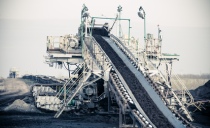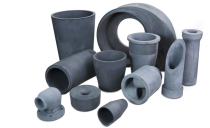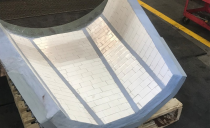Saint-Gobain Performance Ceramics & Refractories’ pioneering Durafrax® material was employed in some of the first ceramic linings the late 1960s and early 1970s.
Durafrax® was first used as a lining material to handle abrasive bulk materials across a range of industries, rapidly becoming the industry standard for abrasive material handling.
Saint-Gobain Performance Ceramics & Refractories’ portfolio of materials – including the Durafrax®, Durastrike® and Corguard® lining systems – can help equipment withstand any type of wear, from erosion to heavy impact by dense abrasive materials.
Features and Benefits
- Extraordinary wear life versus metals, rubbers, plastics and rubber/ceramic composites
- Smooth surface finish ensures minimal COF – ideal for sticky materials
- No moisture absorption, helpful in avoiding material hang-ups
- Bins, hoppers and storage silos
- Flop gates, head boxes and divertors
- Skirt and bang boards
- Chutes, transfer points, pantlegs and spoons
- Weirs and rock boxes
| Aluminum Oxide (Al2O3) | Silicon Carbide (SiC) | Zirconium | Monolithic Castables | |||||||||
| Alpha Al2O3 | Nitride Bonded SiC | Reaction Bonded SiC | Reaction Bonded SiC | Sintered Alpha SiC | Zirconia Toughned Alumina | Fused Cast AZS | Silicon Carbide | |||||
| Durafrax® | Cryston® | Cryston® TW | Cast Refrax® 20 | Refrax® 20 | Norfrax® RB | Silit® SKD | HAMMERfrax® | Hexoloy® | Durastrike® ZTA | ZAC - Corguard® | Wearfrax® RS58 | |
| Properties | ||||||||||||
| Density, g/cm3 | 3,52 | 2,77 | 2,77 | 2,77 | 2,62 | 3,05 | 3 | 3,04 | 3,15 | 4,2 | 3,72 | 2,45 |
| Porosity, % | 0 | 8 | <1 | 15 | 16 | 0 | 0 | 1 | 2 | 0 | 1.15 (Skin) | - |
| Thermal Conductivity, W/m·K | 18 | 16,3 | 23,7 | 13,8 | 16,3 | 125 | 35 | 125 | 125,6 | - | - | - |
| Thermal Expansion, x10-6/°C | 8,3 | 3,2 | 4,3 | - | 4,7 | 4,3 | 4,5 | 4,3 | 4,02 | - | - | - |
| Vickers Hardness, Gpa | 9 | 23 | 11,6 | - | - | 22 | - | 22 | - | - | 19,6 | - |
| Abrasion Resistance C704 | 1 | 1,6 | 1,5 | 1,9 | 2,5 | 0,7 | 0,7 | 0,7 | 0,4 | 0,6 | 1,1 | 8,2 |
| Max Use Temp, °C | 1,250 | 1,590 | 1,450 | 1,450 | 1,590 | 1,350 | - | 1,350 | 1,900 | 1,500 | 1,650 | 500 |
| Aluminum Oxide (Al2O3) | Silicon Carbide (SiC) | Zirconium | Monolithic Castables | |||||||||
| Alpha Al2O3 | Nitride Bonded SiC | Reaction Bonded SiC | Reaction Bonded SiC | Sintered Alpha SiC | Zirconia Toughned Alumina | Fused Cast AZS | Silicon Carbide | |||||
| Durafrax® | Cryston® | Cryston® TW | Cast Refrax® 20 | Refrax® 20 | Norfrax® RB | Silit® SKD | HAMMERfrax® | Hexoloy® | Durastrike® ZTA | ZAC - Corguard® | Wearfrax® RS58 | |
| Sliding Abrasion | +++ | + | ++ | + | + | +++ | +++ | ++++ | ++++ | ++++ | ++ | + |
| Erosion | +++ | + | + | + | + | ++ | ++ | +++ | ++++ | ++++ | ++ | + |
| Impact | + | ++ | + | + | + | + | + | ++ | + | +++ | +++ | + |
| Corrosion Resistance | ++ | ++ | ++ | ++ | ++ | +++ | +++ | ++ | ++++ | ++ | ++ |
+ |
| Thermal Shock | + | + | ++ | ++ | ++ | ++ | ++ | ++ | ++ | ++ | ++ | ++ |
| Thermal Insulation | + | ++ | ++ | ++ | +++ | + | + | + | + | + | ++ | ++ |
| Electrical Insulation | ++++ | NA | NA | NA |
NA |
NA | NA | NA | NA | +++ | ++ | NA |
FAQ
AR400 in chutes typically lasts around a year before requiring replacement – how does the service life of ceramics compare to this?
Ceramics have been found to perform 8-12 times better than AR400 in terms of chute service life, depending on the application.
How do ceramics perform against chrome carbide overlay in terms of wear-resistance?
Ceramics have been found to perform 3-5 times better than chrome carbide overlay in terms of wear resistance, depending on the application.
Will ceramics help reduce operational noise?
Yes. Ceramics can drastically reduce noise in chute work.
Documents
Related Content
Wear Resistant Technologies
Saint-Gobain Performance Ceramics and Refractories have developed a range of wear resistant technologies using alumina oxides (Al2O3 and ZTA) as well as...




